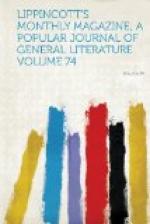Let us pass on to the beginning of 1851. Having then been stationary at Benares for a whole year, I was longing for a little variety. Oude, deservedly called the Garden of India, was, by all accounts, well worth visiting. I resolved to visit it. But not merely was independent exploration in that kingdom attended with risk: in strict propriety, one had no business there except by royal authority, which royal authority, as concerned a traveler, strongly recommended itself to respectful consideration from including a guard, and that free of expense. An acquaintance of mine wrote a letter for me to the Resident at Lucknow, Sir Henry Sleeman. The royal authority was obtained, and the guard inclusive was to meet me on the Oude frontier. Tents were borrowed; servants and camels were hired; long consultations were held with old stagers in the marching line. The canvas which was to shelter me for six weeks was built up in front of my house, and already I felt myself half a nomad. The last evening was spent with veterans in the ways of camping out, and at three o’clock the next morning I mounted my horse and began my journey. My road lay through Jaunpoor, and here I encountered a violent thunderstorm in the middle of the night, with floods of rain. At the cost of being almost drowned out and blown away, I learned the expediency of trenching one’s tabernacle, and the wisdom of putting one’s confidence in none but brand-new cordage. In the city of Jaunpoor there is not much to arrest notice, saving its very durable bridge, dating from the time of Akbar, and the Atala Masjid, a mosque deformed from a rather ancient Hindoo temple; and the rest of the district of Jaunpoor which my route lay through was altogether uninteresting. The borders of the district crossed, after traversing a narrow strip of Oude I came again to British territory. This fragment formed a perfect island, so to speak, the domains of the nawab hemming it in on every side. The one European inhabitant of this isolated but fertile spot was an indigo-planter, near whose bungalow and factory I encamped for a night. His establishment was of long standing, but he had no neighbor within many miles, and there was that about the place which filled me with a sense of utter dreariness and depression. Hard by the house was a burial-ground, and wholly by that house it had been peopled with all its many tenants. Saddening were the brief and almost unvaried histories recorded on its unpretending monuments. There was a name, and then a date, and then that word at the bare mention of which there are few old Indians who, as it calls up memories of bygone shocks and griefs, can refrain from a sickening shudder—“cholera.” Among all who rested there in peace, so far away from every reminder of childhood and of home, not one had passed the prime of life. It was easy to picture to one’s self the last gloomy hours of those hapless exiles, stricken down by the fell scourge in the pride of their strength, and perhaps at the full




